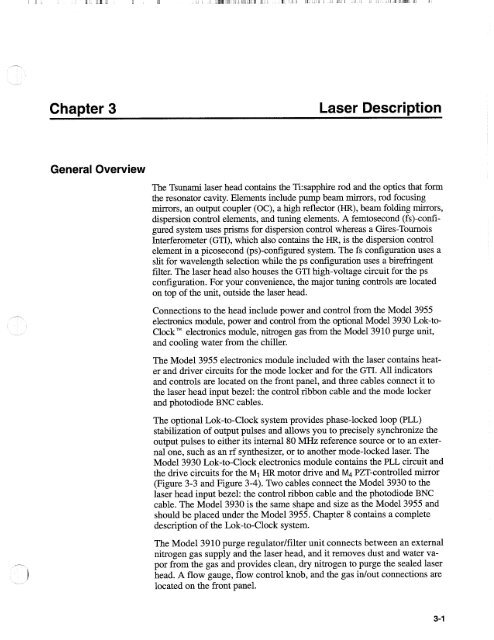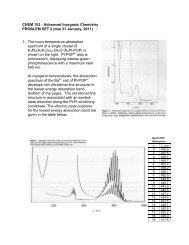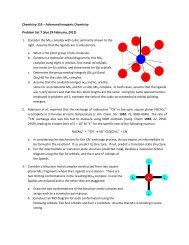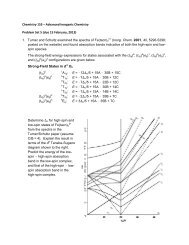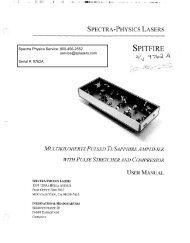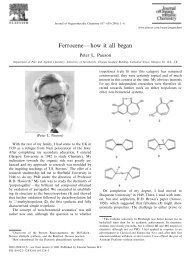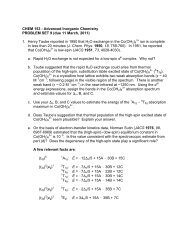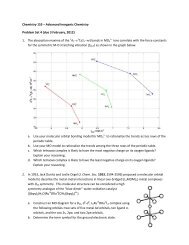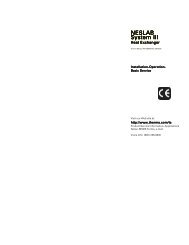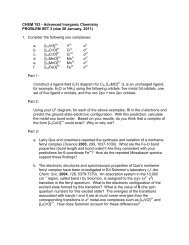Tsunami - Beckman Institute Laser Resource Center
Tsunami - Beckman Institute Laser Resource Center
Tsunami - Beckman Institute Laser Resource Center
You also want an ePaper? Increase the reach of your titles
YUMPU automatically turns print PDFs into web optimized ePapers that Google loves.
Chapter 3<br />
<strong>Laser</strong> Description<br />
General Overview<br />
The <strong>Tsunami</strong> laser head contains the Ti:sapphire rod and the optics that form<br />
the resonator cavity. Elements include pump beam mirrors, rod focusing<br />
mirrors, an output coupler (OC), a high reflector (HR), beam folding mirrors,<br />
dispersion control elements, and tuning elements. A femtosecond (fs)-configured<br />
system uses prisms for dispersion control whereas a Gires-Tournois<br />
Interferometer (GTI), which also contains the HR, is the dispersion control<br />
element in a picosecond @s)-configured system. The fs configuration uses a<br />
slit for wavelength selection while the ps configuration uses a birefringent<br />
filter. The laser head also houses the GTI high-voltage circuit for the ps<br />
configuration. For your convenience, the major tuning controls are located<br />
on top of the unit, outside the laser head.<br />
Connections to the head include power and control from the Model 3955<br />
electronics module, power and control from the optional Model 3930 Lok-to-<br />
Clock" electronics module, nitrogen gas from the Model 3910 purge unit,<br />
and cooling water from the chiller.<br />
The Model 3955 electronics module included with the laser contains heater<br />
and driver circuits for the mode locker and for the GTI. All indicators<br />
and controls are located on the front panel, and three cables connect it to<br />
the laser head input bezel: the control ribbon cable and the mode locker<br />
and photodiode BNC cables.<br />
The optional Lok-to-Clock system provides phase-locked loop (PLL)<br />
stabilization of output pulses and allows you to precisely synchronize the<br />
output pulses to either its internal 80 MHz reference source or to an external<br />
one, such as an rf synthesizer, or to another mode-locked laser. The<br />
Model 3930 Lok-to-Clock electronics module contains the PLL circuit and<br />
the drive circuits for the MI HR motor drive and M4 PZT-controlled mirror<br />
(Figure 3-3 and Figure 3-4). Two cables connect the Model 3930 to the<br />
laser head input bezel: the control ribbon cable and the photodiode BNC<br />
cable. The Model 3930 is the same shape and size as the Model 3955 and<br />
should be placed under the Model 3955. Chapter 8 contains a complete<br />
description of the Lok-to-Clock system.<br />
The Model 3910 purge regulatorlfilter unit connects between an external<br />
nitrogen gas supply and the laser head, and it removes dust and water vapor<br />
from the gas and provides clean, dry nitrogen to purge the sealed laser<br />
head. A flow gauge, flow control knob, and the gas idout connections are<br />
located on the front panel.


